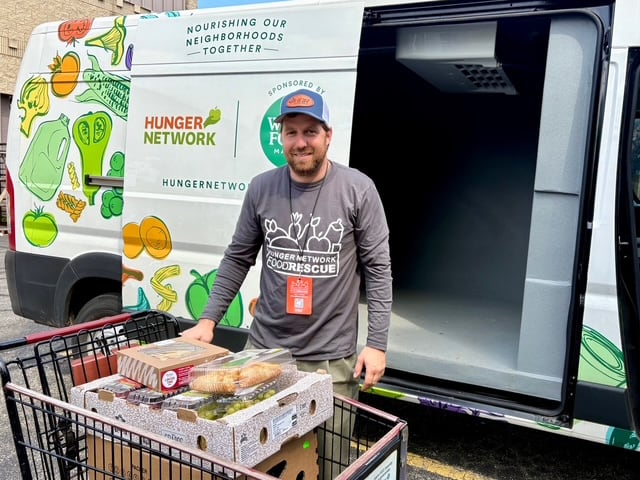CLEVELAND, Ohio – Roger Himmelright maneuvers a refrigerated food truck through the Giant Eagle parking lot in Brook Park. Instead of heading for the main entrance, he pulls around to the delivery area. His mission: to rescue food that would otherwise be thrown away.
Inside, he picks up a box with 18 containers of cherries and six bags of red and green grapes. The bakery section contributes a lemon blueberry pie and a package of four apple turnovers with a sell-by date from the previous day.
“The store isn’t going to sell them by that point, but it’s fine to use,” Himmelright, food rescue director for the Hunger Network, says, explaining that the “sell by” and “best by” dates denote quality timelines for retailers, not when food becomes unsafe to eat. It’s the “use by” dates, he says, that indicate when something may expire.
Himmelright then drives the items less than two miles down the street to Audrey’s Outreach Food Pantry, where they’ll be immediately handed over to residents in need. Most pantries rely on canned goods and shelf-stable items, so they always appreciate receiving fresh food, he notes.
The pantry didn’t open for another hour, but the line of waiting cars was already spilling out into the street, past a stoplight.
“Maybe only the first 10 cars get a bag of cherries,” Himmelright says, recognizing that food donations often come in small quantities. But there’s still the benefit that “this was something good; this was something people wanted.”
This is the Hunger Network’s food rescue program in action. It collects unsold or unserved food from about 200 donor sites, including restaurants and grocery chains like Giant Eagle and Whole Foods, and then delivers them to food pantries, Head Start programs, senior centers and transitional housing facilities to be handed out or incorporated in meal services.
They take fruits, vegetables, cheeses, meats and baked goods, as well as prepared foods from catering events. GetGo gas stations routinely provide premade sandwiches, Himmelright said.
And the program is becoming all the more important given the
Greater Cleveland Food Bank recently lost 553,000 pounds
of food and millions of dollars in state and federal funding—resources that typically stock the shelves at other area pantries, including Hunger Network’s MidTown Market. That means sites might soon have less inventory or close altogether.
Hunger Network itself faced closing 17 hot meal sites that it supports after federal funding stalled earlier this year.
County Council recently proposed $80,000
in emergency funding to keep them open while the organization works toward another solution. It’s expected to formally approve that funding next week.
Volunteer-run
The pickups and drop-offs are done by volunteer “food rescue heroes,” who track donations on the
Hunger Network Food Rescue App
. It shows users where to pick up, what’s being collected, and the drop-off location. It even provides real-time directions and photos to guide drivers to the right entrance.
Food is usually delivered nearby, within a few miles, to make it easier for drivers and to ensure that items sourced from the neighborhood stay in the neighborhood, Himmelright said. People only need a smart phone, working vehicle and background check to volunteer.
Volunteers and donation sites can learn more about the program at hungernetwork.org.
Next Step: A Rescue Kitchen
While the food rescue program helps offset grocery bills and save millions of pounds of food from the trash, food insecurity and hunger persist in communities, according to Krystal Franklin, Hunger Network’s Partnerships Manager.
Hunger Network is working on opening a food rescue kitchen this fall to help fill the gap and support the hot meal sites long-term. It would allow the program to repurpose larger quantities of donated items into ready-to-eat meals that could be cooked the same day, frozen, or preserved as jams or jellies.
The model draws inspiration from La Soupe in Cincinnati, which Himmelright said now produces about 35,000 meals weekly using rescued food.
“We can stop the pipeline of food to the garbage and make something usable out of it,” he says.
Eventually, Himmelright, who has nearly two decades in the food industry, envisions scaling up operations to include food deliveries or homebound seniors and running a pizza shop or food truck to help fund the program. That would require a lot more volunteers and food donations, though, he notes.
After the pantry stop, Himmelright heads to LongHorn Steakhouse in Seven Hills. The location usually donates leftover potatoes and onions every Monday, but that day’s haul brought a surprise: six frozen porterhouse steaks and a bag of salmon fillets.
Himmelright delivers the items to a FrontLine Service transitional housing facility in Garfield Heights, where a staff member immediately begins meal planning.
“Yeah, we can cook this up for them tonight,” the man says to himself, already heading toward the kitchen.
Generative AI was used to organize information for this story.
Stories by
Kaitlin Durbin
-
After-school programs potentially saved from Trump administration freeze, but ‘realistically, this thing is dead’ some still warn
-
Gateway shifts funds, relies on IOUs to stay afloat while awaiting funding fix — with staff pay raises on deck
-
‘A leap of faith’: Cuyahoga County will replace Diversion Center with new behavioral health crisis center
-
Where can political campaigners stand at the new Cuyahoga County Board of Elections office? Officials drafting new rules






